

Gt.pdf. University of Bath Single Sign-on. CHED_article_EnglishAdditionalLanguage_Madiba_2010. Marzanos 9 strategies.pdf. Creese%20bilingual%20teaching%20turkish%20in%20the%20uk.pdf. Developing_quality_tuition_-_english_as_an_additional_language.pdf. The Pragmatics of Politeness. Leech and Wilson (1983) - All About Linguistics. We will be reviewing the following articles that look at Verbal Irony: Leech, Geoffrey. (1983) The Principle of Pragmatics.
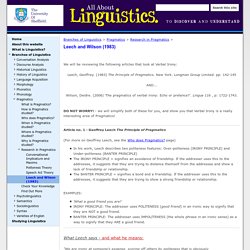
New York. Longman Group Limited. pp: 142-145 Wilson, Deidre. (2006) 'The pragmatics of verbal irony: Echo or pretence? '. Lingua 116 , p: 1722-1743. DO NOT WORRY! Article no. 1 - Geoffrey Leech The Principle of Pragmatics In his work, Leech describes two politeness features: Over-politeness (IRONY PRINCIPLE) and Under-politeness (BANTER PRINCIPLE)The IRONY PRINCIPLE = signifies an avoidance of friendship. 'What a good friend you are! ' What Leech says - and what he means: "We are ironic at someone's expense, scoring off others by politeness that is obviously insincere. " (For example, have you heard the phrase: 'it's not what you say it's how you say it'? "The ironic force of a remark is often signalled by exaggeration or understatement. " A remark such as 'look whose here' - when taken literally, is simply a command to look.
Another branch... 'Big Bang Theory' explained: 1.) Yang_vol8.pdf. Language and Education Supporting pupils with EAL and their teachers in Ireland: the need for a co- ordinated strategy. L.

Murtagh and T. Francis developing children’s language, therefore, is vital, as it not only allows them access tothe curriculum but also provides them with the language skills and cultural knowledgeto integrate into school life and Irish society (Culleton 2004). The dominant language of instruction in the Irish education system is English and newcomer children who are not proficient in English (approximately 75% according to Smyth et al. 2009, 44–5) experience barriers to full participation in education.
As inclusive education is an important aim of the Irish education policy, additional support is necessary for pupils with limited English proficiency. N. Ontological and Epistemological Foundations of Qualitative Research. Volume 10, No. 2, Art. 30 – May 2009 Ontological and Epistemological Foundations of Qualitative Research Irene Vasilachis de Gialdino Abstract: The purpose of this paper is to describe the most relevant features of qualitative research in order to show how, from the Epistemology of the Known Subject perspective I propose, it is necessary to review first the ontological and then the epistemological grounds of this type of inquiry.

I begin by following the path that leads from the Epistemology of the Knowing Subject to the Epistemology of the Known Subject, proposed as a new and non exclusive way of knowing. I pass on to describe the primary and secondary characteristics of qualitative research, expressing the need for an ontological rupture. Key words: Epistemology of the Knowing Subject; Epistemology of the Known Subject; cognitive interaction; cooperative knowledge construction. Academic Phrasebank. Module 2 Ffd[1] The importance of a good seating plan. There are different schools of thought on the seating plan.

I have a particular methodology, which I’ll explain later, but first, a bit on why classroom organisation is the most important philosophical decision you will make in your career and why you should turn your face away from the darkness and towards the light. Here’s a shock. You are not necessarily the cleverest person in your classroom. Teacher echo, teacher echo: helpful, or greedy and controlling? Recently listening to Cecilia Lemos’ great talk on recasting as a form of correction, and how she had decided it was not always very effective, I started thinking again about teacher echo.

Recasting is repeating an utterance which is incorrect, in the correct way, hoping that the student will notice it. As a technique, it has its roots in the ‘strong’ communicative approach, and is based on what parents tend to do with young children, as they are learning. However, there is quite a lot of evidence that students rarely do notice recasts. Culture Bound: Bridging the Cultural Gap in Language Teaching. Learning_Theories. Learning_Theories. Conducting Case Studies. M_e_tool_series_case_study.pdf. Execsummary.pdf. Studies in Second Language Acquisition - Abstract - LEARNING WITHOUT AWARENESS REVISITED. Research Articles Extending Williams (2005) Mika Hamaa1 c1 and Ronald P.
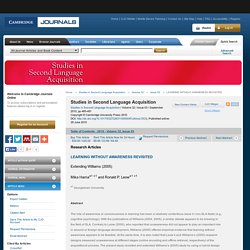
Leowa1 c1 a1 Georgetown University Abstract The role of awareness or consciousness in learning has been a relatively contentious issue in non-SLA fields (e.g., cognitive psychology). (Received September 15 2009) Sla. Sla. Second-language Teaching Methods. This module provides a description of the basic principles and procedures of the most recognized and commonly used approaches and methods for teaching a second or foreign language.

Each approach or method has an articulated theoretical orientation and a collection of strategies and learning activities designed to reach the specified goals and achieve the learning outcomes of the teaching and learning processes. Jill Kerper Mora The following approaches and methods are described below: Grammar-Translation Approach Direct Approach Reading Approach. Helmut Leitner: Pattern Languages and Christopher Alexander: Introduction and Crash Course. Pattern language. A pattern language is a method of describing good design practices within a field of expertise.
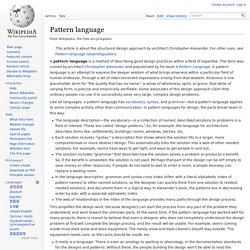
The term was coined by architect Christopher Alexander and popularized by his book A Pattern Language. A pattern language is an attempt to express the deeper wisdom of what brings aliveness within a particular field of human endeavor, through a set of interconnected expressions arising from that wisdom. Aliveness is one placeholder term for "the quality that has no name": a sense of wholeness, spirit, or grace, that while of varying form, is precise and empirically verifiable.
Some advocates of this design approach claim that ordinary people can use it to successfully solve very large, complex design problems. Like all languages, a pattern language has vocabulary, syntax, and grammar—but a pattern language applies to some complex activity other than communication. Models vs. Patterns. Introduction. Patterns Patterns are a systematic way to capture the experience of experts about good or best practices and document these nuggets of wisdom in an accessible way for designers.
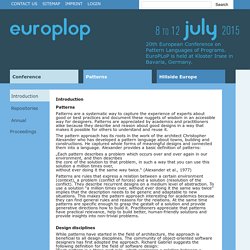
Patterns are appreciated by academics and practitioners alike because they describe and reason about good designs in a way that makes it possible for others to understand and reuse it. The pattern approach has its roots in the work of the architect Christopher Alexander who has developed a pattern language about towns, building and constructions. Models Pages. Stretch and Fold. Radical Inquiry. Radical Inquiry is a process of using three questions to clarify vision for an individual or group to help them identify specific actions for moving toward what they want.
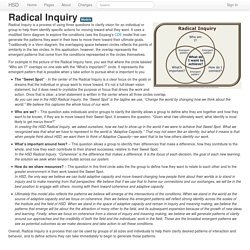
It uses a modified Venn diagram to explore the conditions (see the Eoyang’s CDE model that can generate the patterns they want in their lives to move them toward their ultimate goals. Traditionally in a Venn diagram, the overlapping space between circles reflects the points of similarity in the two circles. In this application, however, the overlap represents the emergent patterns that come from the conditions represented in the circles themselves.
Pattern Spotters. This is a useful tool that helps individuals and groups reflect on an experience. Sometimes referred to as “generative” questions, they can generate insights and dialogue by opening group participants to each other’s ideas. The questions ask for five perspectives on a single event. Learning_Triangle_2011__2_.pdf. Debotetal2007-bilingualism.pdf. Preview_Article_accepted_version.pdf. Language as a dynamical system. In Robert F. Port & T. van Gelder (Eds.) Mind as Motion: Explorations in the Dynamics of Cognition. Cambridge, MA: MIT Press, 1995. Pp. 195-223. Jeffrey L. University of California, San Diego Introduction. A Dynamic Model of Multilingualism by Philip Herdina, Ulrike Jessner - Multilingual Matters. The model presented in this volume draws together various strands of research – second language acquisition theory, bilingualism research, dynamic systems theory – to develop a novel approach to this challenging subject.
Its main focus lies on the psycholinguistic dynamics of multilingualism, the processes of change in time affecting two or more language systems. The authors take up the courage to break with conventional language acquisition theory and provide a new, dynamic view of language processing where language maintenance and language loss are seen as determining factors in multilingual competence. The novelty and special value of the book is that it pioneers the way to learning more about the differences between bilingualism and trilingualism.
BBC Radio 4 - The Educators, John Hattie.
Teachit ELT Teacher Training Bulletin. University of Bath Single Sign-on.